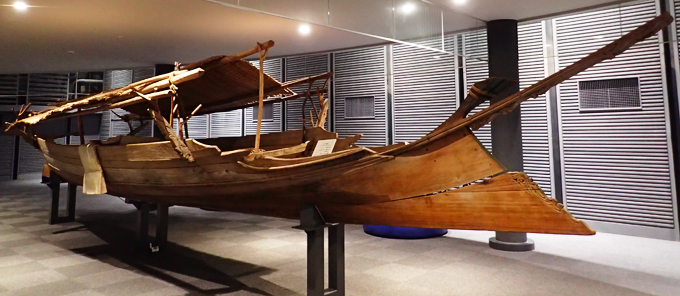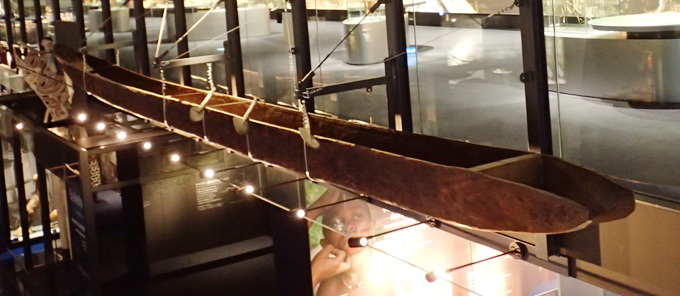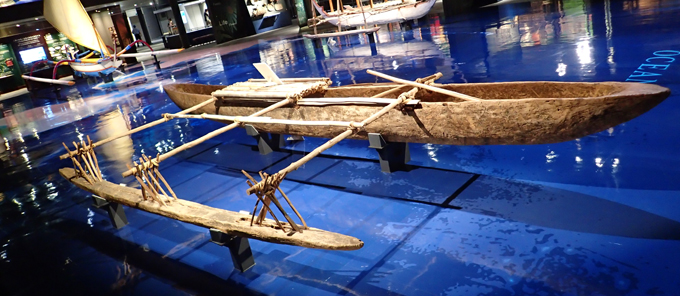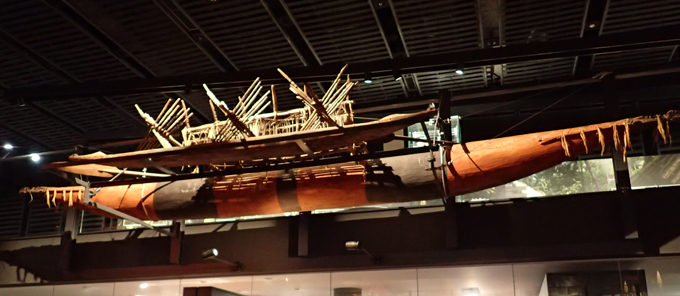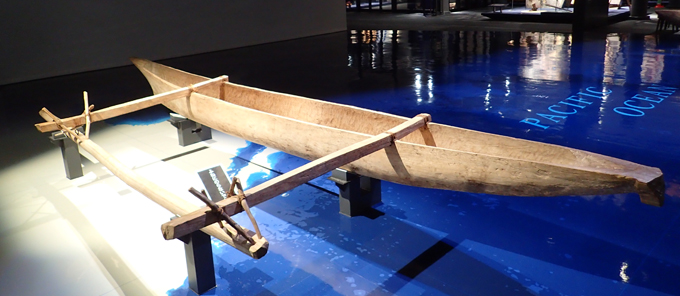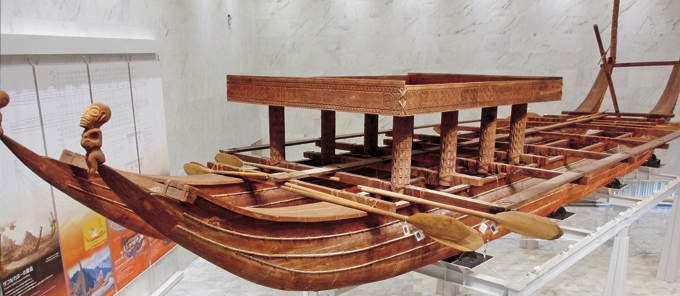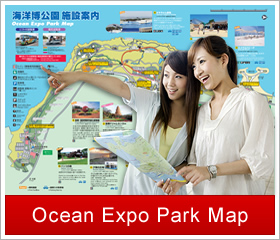Oceanic Culture Museum, Planetarium
- HOME
- Facilities
- Oceanic Culture Museum Planetarium
- Oceanic Culture Museum Exhibition Hall
Oceanic Culture Museum Exhibition Hall
A place that introduces the history and culture of the maritime people in the Pacific region including Okinawa.
The items displayed here were made when Okinawa Ocean Expo was held in 1975. They preserve and pass down to the present time the oceanic culture of the Asia-South Pacific region of the 1970s.
“Oceanic culture” can also be said to be the outcome of one’s soul cultivated through the interchange between the “ocean” of Mother Nature and the “human beings” that live by it daily. People are tempted to co-exist with the ocean by its fascination. That is what created “ships” which connect the ocean and people, and invokes the will to venture into the unknown.
This Oceanic Culture Museum introduces the intercommunion of people that takes place on such oceans, i.e. “oceanic culture” and its culture and history.
A voyage to the Pacific rim that especially relates deeply with the history of Japan and Okinawa begins guided by abundant materials and interesting narration. Turn your thoughts to the “oceanic culture” of our ancestors and that of ourselves to come.
Life in the Pacific and Okinawa(movie)
Canoes exhibited at the Oceanic Culture Museum

-
 Double-hulled Canoe (Tahiti Island, French Polynesia)
Double-hulled Canoe (Tahiti Island, French Polynesia) -
 The Lien Polowat (Polowat Island, Federated States of Micronesia)
The Lien Polowat (Polowat Island, Federated States of Micronesia) -
 Kura canoe (Kiriwina Island, Papua New Guinea)
Kura canoe (Kiriwina Island, Papua New Guinea) -
 Lakatoi (Port Moresby, Papua New Guinea)
Lakatoi (Port Moresby, Papua New Guinea) -
 Bajou house boat (Sulu Sea, Philippines)
Bajou house boat (Sulu Sea, Philippines) -
 Watom single-outrigger canoe (Watom Island, Papua New Guinea)
Watom single-outrigger canoe (Watom Island, Papua New Guinea) -
 Sepik River canoe (Sepik River, Papua New Guinea)
Sepik River canoe (Sepik River, Papua New Guinea) -
 Vanuatu single-outrigger canoe (Pentecost Island, Vanuatu)
Vanuatu single-outrigger canoe (Pentecost Island, Vanuatu) -
 Bali double-outrigger canoe (Bali Island, Indonesia)
Bali double-outrigger canoe (Bali Island, Indonesia) -
 Tao plank-built boat (Lanyu Island, Taiwan)
Tao plank-built boat (Lanyu Island, Taiwan) -
 Schouten Islands single-outrigger canoe (Schouten Island, Papua New Guinea)
Schouten Islands single-outrigger canoe (Schouten Island, Papua New Guinea) -
 Samoan single-outrigger canoe (Upolu Island, Samoa)
Samoan single-outrigger canoe (Upolu Island, Samoa) -
 Okinawa’s boats (Japan Okinawa)
Okinawa’s boats (Japan Okinawa)
Bajau house boat
- Place: Sulu sea, Philippine
- Total length: about 9.5 m
- Material: nipa palm, Rattan
- Collected in the 1970s
Sepik River canoe
- Place: Sepik river, Papua New Guinea
- Total length: about 11 m
- Collected in the 1970s
Watom single-outrigger canoe
- Place: Watom Island, Papua New Guinea
- Total length: about 5 m
- Material: Wood
- Collected in the 1970s
Vanuatu single-outrigger canoe
- Place: Pentecost Island, Vanuatu
- Total length: about 5.9 m
- Collected in the 1970s
Schouten Islands single-outrigger canoe
- Place: Schouten Island, Papua New Guinea
- Total length: about 6.7 m
- Collected in the 1970s
The Expance of Oceanic Culture
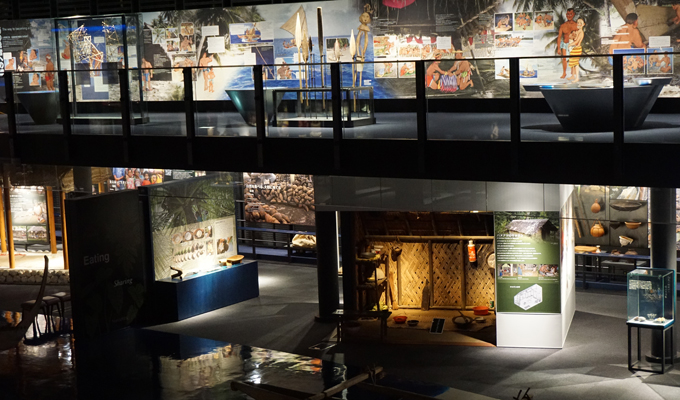
The Oceanic Culture Museum offers many opportunities for contacting with culture and customs of Oceanian regions. Our galleries consist of tools and artifacts with various themes such as clothing, food, housing, fish catching, music, dance and religion.
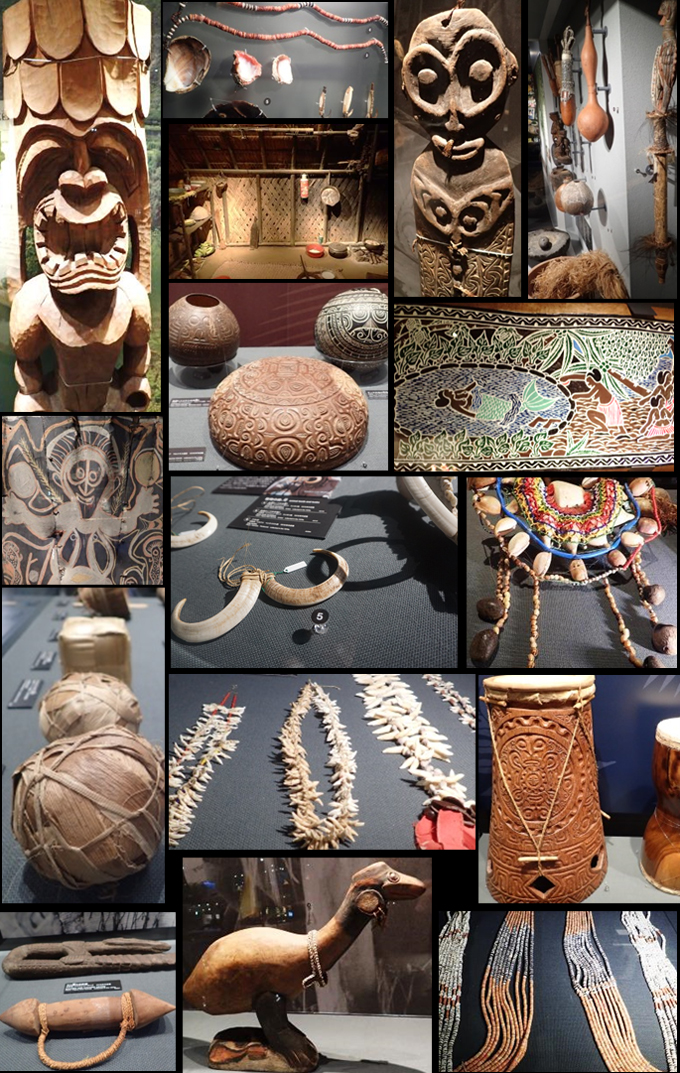
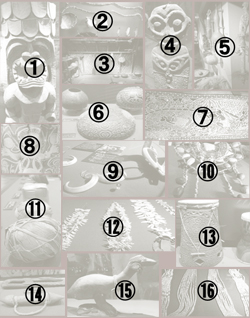
-
 Sculpture of Ku (Hawaii)
Sculpture of Ku (Hawaii) -
 Things made with materials from the sea (Solomon Islands)
Things made with materials from the sea (Solomon Islands) -
 Vanuatu kitchen (Vanuatu)
Vanuatu kitchen (Vanuatu) -
 Sculpture of fertillty (Papua New Guinea)
Sculpture of fertillty (Papua New Guinea) -
 Betel chewing and Kava tools (Papua New Guinea / Samoa / Vanuatu)
Betel chewing and Kava tools (Papua New Guinea / Samoa / Vanuatu) -
 Wooden bowl (Marquesas Islands, French Polynesia)
Wooden bowl (Marquesas Islands, French Polynesia) -
 Story board (Palau)
Story board (Palau) -
 Ancestor image (Papua New Guinea)
Ancestor image (Papua New Guinea) -
 Animal teeth and tusks (Papua New Guinea / Vanuatu)
Animal teeth and tusks (Papua New Guinea / Vanuatu) -
 Mwali (Trobriant Island, Papua New Guinea)
Mwali (Trobriant Island, Papua New Guinea) -
 Pandanus ball (Marshall Islands)
Pandanus ball (Marshall Islands) -
 Local money (Solomon Islands)
Local money (Solomon Islands) -
 Drum (French Polynesia)
Drum (French Polynesia) -
 Knuckles (Chuuk Islands, Federated States of Micronesia)
Knuckles (Chuuk Islands, Federated States of Micronesia) -
 Carving of a cassowary (Papua New Guinea)
Carving of a cassowary (Papua New Guinea) -
 Red shell money (Malaita Island, Solomon Islands)
Red shell money (Malaita Island, Solomon Islands)

Entrance Hall (1st floor hall)
Double Canoe of the Oceanic Culture Museum
A canoe that has been exhibited since Okinawa Ocean Expo was held in 1975.
This double canoe was designed by Mr. Herbert Kane based on historical records and restored by the people of Tahiti.
Double-canoe(movie)
Navigation Zone (3rd floor loft)
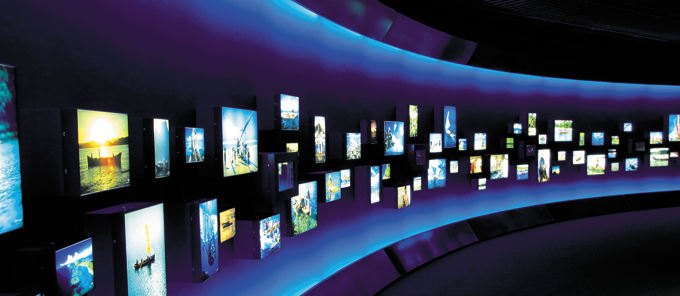
The Navigation zone displays a video on how people migrated as they made great voyages headed to a new world.
The traditional navigation and naval engineering of Micronesia, which developed after a long period of time and is still passed down to the present time, is introduced via the first bande dessinee (serial comic strip) in Japan that extends over 33 yd. There are also displays of tools used for learning navigation (sidereal compass and stick chart) and items to take on a voyage.
Traditional Navigation(movie)
People Who Crossed the Ocean々
Groups of people whose livelihood was on the ocean took a long period of time to bring about naval engineering and navigation. These people continued their journey to the east, and widely spread out over the vast Pacific area. This process is introduced using panels and videos.

Bande Dessinee (serial comic strip) Exhibit
By the use of a “serial comic strip” method, topics of “how to become a traditional navigator” and “how to build a traditional canoe” is introduced in a way that’s easy to understand using wall paintings each extending over 33 yd.
Collection of Canoes
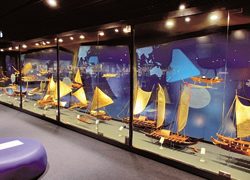
An area where models of unique canoes of various regions of Oceania are on exhibit.
Oceania Zone (2nd floor hall)
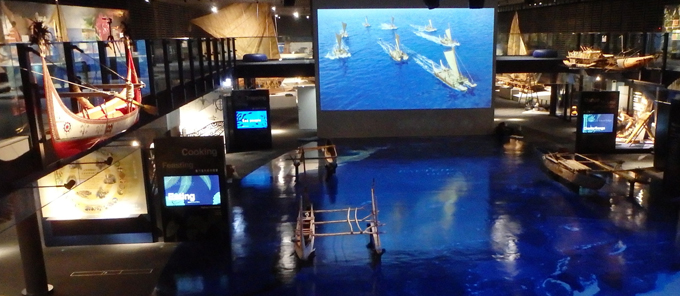
The Oceania Zone not only introduces the wisdom and courage of people, but also introduces the culture of Oceania through such topics as shelters, food, clothing, religions, music, dance, and fisheries. These are shown among the voyages that took place in the vast expanse of the ocean through dynamic images using the map on the floor and a large screen. There is also an experience booth.
On the floor of the exhibit hall stretching 33 yd x 16 yd is a map of the Pacific Ocean, and the “People Who Crossed the Ocean” are illustrated on a large screen.
Intercommunion Zone
The Intercommunion Zone exhibits three large canoes which represent the “intercommunion formed by the ocean”. They are the Lakatoi canoe which was used for trade, the Kula canoe which was used for rite of exchange to form friendship, and the “Lien Polowat”, a voyaging canoe of Micronesia, which is still used as a method of transportation by the inhabitants.

Lien Polowat
It was built on Polowat Island using a traditional canoe building technique of Micronesia. It is a canoe that actually made a voyage of 497 miles from Polowat to Guam by traditional navigation (Star Navigation) in five days.
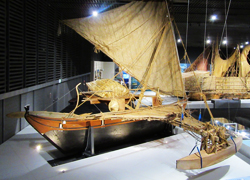
The lien polowat
- Place: Polowat Island, Federated States of Micronesia
- Material: Bread fruit tree, Beach hibiscus, Calophyllum inophyllum, Coconut palm, Pandanus leaves
- Total length: about 8.4 m
- Made in 2013
Micronesian Voyaging Canoe(movie)
Kula Canoe
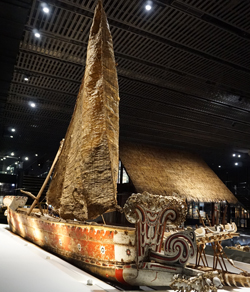
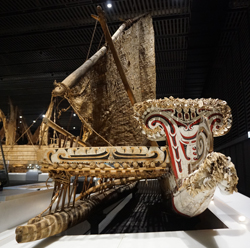
The Kula canoe is a beautiful canoe with unique engraving and coloring, and decorated with cowry. “Kula” stands for a rite of exchanging necklaces and armlets in the Trobriand Islands.
- Place: Kiriwina Island, Papua New Guinea
- Total length: about 10 m
- Collected in the 1970s
Kula Canoe(movie)
Lakatoi
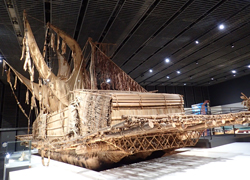
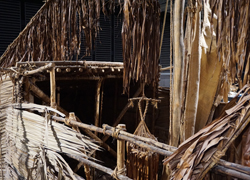
A boat that was used for trade by the Motuan people who live in the Port Moresby area of Papua New Guinea. The displayed Lakatoi is a valuable restoration with the exact same design as the boat that was built in 1974 when Queen Elizabeth II visited Papua New Guinea.
- Place: Port Moresby, Papua New Guinea
- Total length: about 15.5 m
- Material: Bread fruit tree, Pandanus leaves, Eucalytus tree
- Collected in the 1970s
Large Scale Canoe for Trade(movie)
Okinawa Zone

A zone that introduces the fishery life of Okinawa. Traditional fishing gear of Okinawa is displayed, and a video of the traditional skin diving net-fishing (Agiya) is shown. The “Machikifuni (Marukinni)”, just restored in Okinawa for the first time in 60 years, as well as the Sabani boats, “Honhagi” and “Nanyohagi”, are exhibited along with videos of the actual manufacturing process.
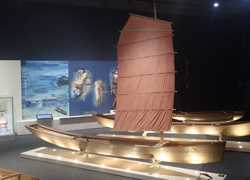
Honhagi (plank-build boat)
- Place: Okinawa, Japan
- Material: Ceder
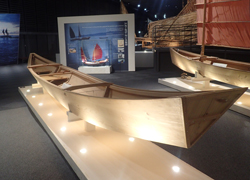
Nanyohagi (plank-build boat)
- Place: Okinawa, Japan
- Material: Ceder
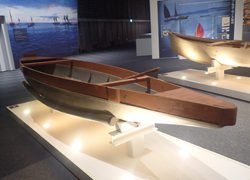
Tankubuni (boat making use of an aircraft fuel tank)
- Place: Okinawa, Japan
- Material: Duralumin

Machikifuni (plank-build boat)
- Place: Okinawa, Japan
- Material: Ryukyu pine tree
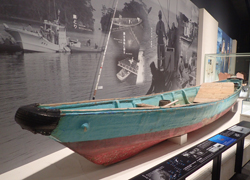
Tatana (boat)
- Place: Okinawa, Japan
- Material: FRP painted wood
Community Zone
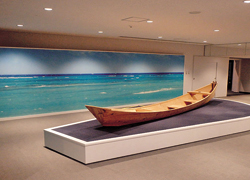
In addition to displays of materials related to Ocean Expo held in 1975, an information search terminal is available. There is also a Sabani to get on aboard and take photos.
